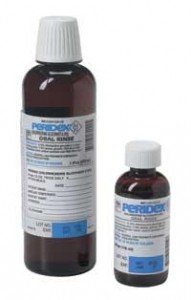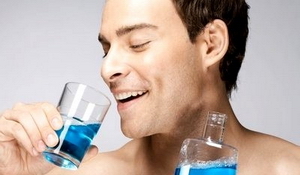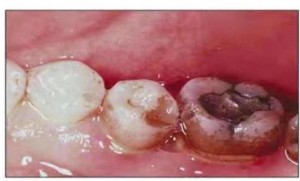Therapeutics mouthwashes are used along with regular toothbrushing and flossing to help reduce gum disease (gingivitis) that causes red, swollen and easily bleeding gums. There are two categories required by the American Dental Association (ADA) to be effective against plaque and gum disease:
1.      Mouthwash that contains essential oils as an active ingredient. For example Listerine® and other generic equivalents sold over the counter.
2.      Mouthwash that contains chlorhexidine gluconate as an active agent which the Food and Drug Administration (FDA) has approved ONLY as prescription products. For example Peridex® and Periogard®.
What is Peridex?
Peridex mouthwash is an FDA approved prescriptive plaque-control rinse that contains 0.12% of chlorhexidine gluconate which is an antimicrobial that reduces bacteria in the mouth. So far chlorhexidine gluconate mouthwash is the most effective anti-plaque and anti-gingivitis to date. Peridex prescription is usually done by your dentist and should only be used to treat the condition your dentist prescribed it for.
What is chlorhexidine gluconate?
Chlorhexidine gluconate is a cationic compound that binds to the tooth surface, plaque bacteria and soft tissues of the mouth thus inhibiting bacteria colonization. The ability of the oral tissues to absorb chlorhexidine gluconate allows it to be slowly released in active form over 12 to 24 hours.
Chlorhexidine gluconate is used to help control gum inflammation and plaque. However it is not the sole method to heal gum disease for chlorhexidine gluconate does not penetrate thick layers of plaque and it could not reach the depth of gum pockets.
Chlorhexidine rinse is recommended to those who have:
- problems maintaining good oral hygiene
- gum disease
- fixed mouth appliances
- implants
- impaired manual dexterity
- after non-surgical scaling of deep gum pockets
- during post-operative healing period of surgical dental treatments.
What precautions should I take before using chlorhexidine?
Before using chlorhexidine, you should tell your doctor or dentist if you are allergic to it. Peridex is under FDA pregnancy category B, which is not expected to be harmful to an unborn baby but do tell your dentist if you are pregnant before using this medication and consult your doctor before breastfeeding for it is not known whether this drug passes into breast milk. It is also best to inform your dentist of your dental history especially fillings, dental crowns or veneers on your front teeth before use.
How should I use Peridex?
The proper way to use Peridex mouth rinse is to rinse twice daily (after breakfast and at bedtime) with 0.5oz (15ml) of solution after brushing. Swish the solution in your mouth for 30 seconds and then spit it out. Do not swallow the solution or mix it with any other substance.
Chlorhexidine gluconate is inactivated by dentifrice (paste, liquid or powder used to help maintain acceptable oral hygiene) substances therefore avoid use 30 minutes before and after regular tooth brushing. It would be advised to wait for 2 hours before rinsing your mouth with water or other mouthwashes, brushing your teeth, eating, or drinking. Do not share Peridex with another person, even if they have the same gum symptoms you have.
What are the Peridex side effects?
Despite its advantages, chlorhexidine gluconate mouthwash may cause some side effects that include:
- Staining on teeth, oral tissues, dentures and tooth-colored fillings brown by binding to dietary factors
- Altered taste
- Increased tartar (calculus) formation on teeth
- Mouth ulcers
- Mouth or throat irritation
- Hypersensitivity reaction
How to minimize the side effects of using Peridex (Chlorhexidine Gluconate)
- To minimize discoloration, you should brush with toothpaste and floss 3 times a day, emphasizing more on the stained areas. Use of “tartar control†toothpaste may be more effective. Both stain and tartar can be removed by your dentist or hygienist therefore you should visit your dental professional every 6 months to get your mouth clean.
- Chlorhexidine gluconate mouthwash should be used only up to two weeks and intake of tea, coffee, red wine and smoking should be avoided during use.
- Chlorhexidine gluconate oral rinse should not be used by persons who have sensitivity to it or its components. If you suffer from any symptoms of an allergy include mouth/skin rash, itching/swelling, trouble breathing and severe dizziness, seek immediate medical attention.
- Chlorhexidine gluconate mouthwash should be used after meals for better food appreciation. Avoid rinsing with water immediately after use for it removes the flavor-masking agent and will result in a bitter taste.
What happens if I miss a dose?
If you happened to miss a dose, use it as soon as you remember unless it is near the time for the next dose or close to a mealtime. In such situations you can skip the dose and resume as normal. Do not double the dose to make up for the missed dose.
What happens if I overdose?
An overdose would only occur if you swallow the medication. Overdose symptoms may include stomach pain, nausea or the appearance of being drunk. If an overdose is suspected, contact a poison control center (US National Poison Hotline at 1-800-222-1222) or emergency room immediately.



my teeth look gray since I’ve used peridex after a gum graft. what can I do? they look terrible
Thank you for your comment. After your gum graft has healed, you do not need to use peridex. Your teeth should not discolor after stopping the use of chlorhexidine mouthwash and you should visit your dentist to help polish your teeth back to its original color.
My taste has been altered since using Chlorhexidine Gluconate. How long will this last?
The altered taste sensation will last as long as you use the chlorhexidine mouthwash. You should feel normal again after you have stopped using it.
I was just prescribed PerioGard. I have porcelain caps and veneers on my front 6 teeth. does this have the possibility of discoloring them?
@Amanda
Discoloration tend to occur more on fillings with rough surfaces but for precaution sake, do not use over 2 weeks and and intake of tea, coffee, red wine and smoking should be avoided during use. If stained, you should brush with toothpaste and floss 3 times a day, emphasizing more on the stained areas.
I have experienced increased tooth sensitivity after using Chlorhexidine 3X per day for three weeks. I backed off and noticed improvement with the sensitivity after concentrating on most sensitive areas with fluoride products and MI paste. Is this a common side effect? Any other suggestions while using? I have stopped all together for now.